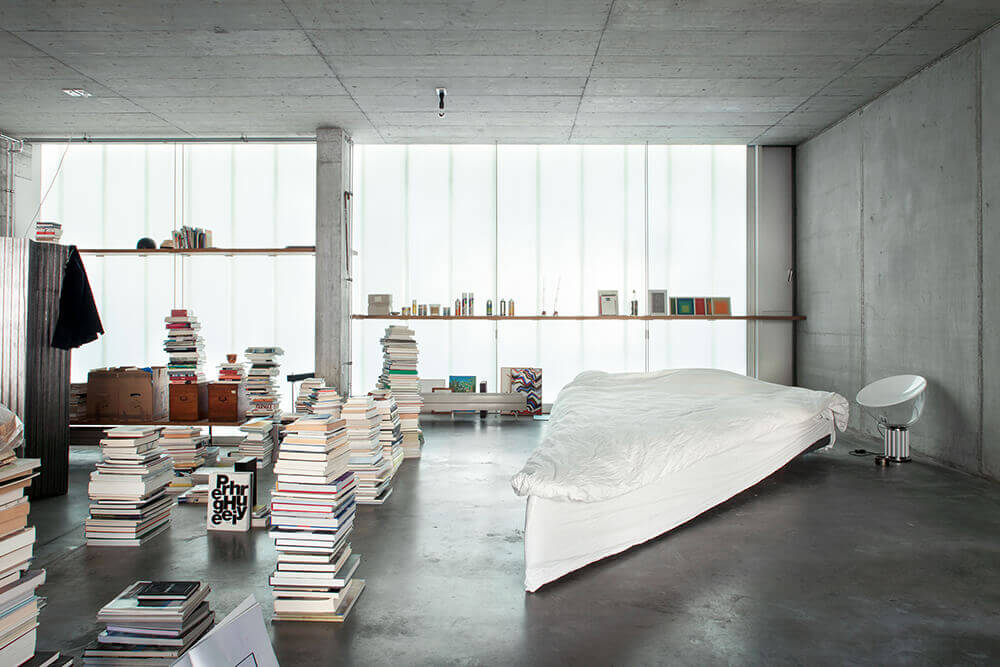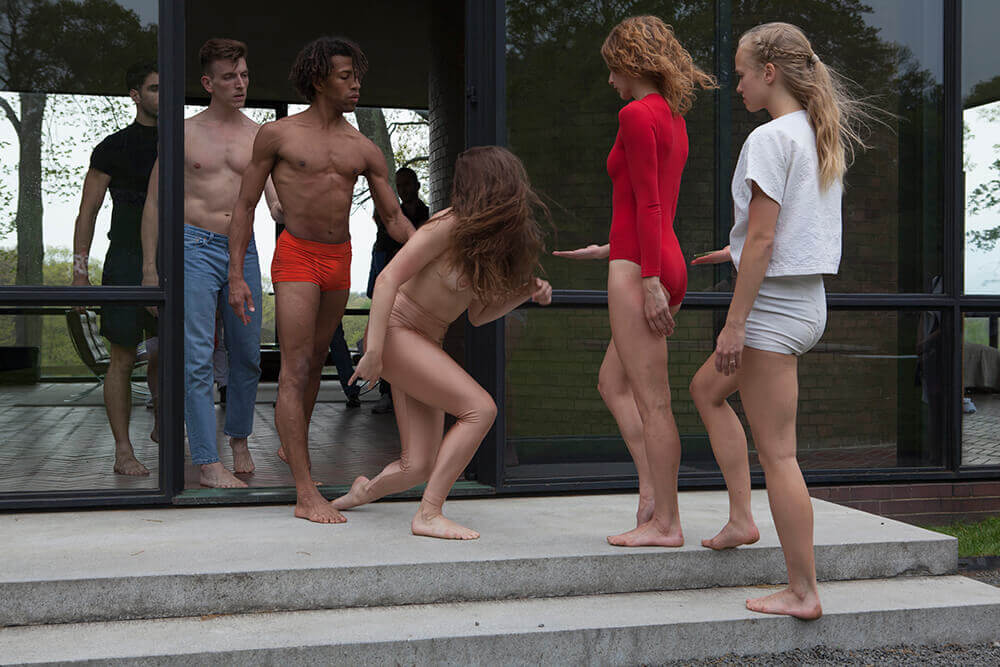Collaborative Consummation
Alexandra Cunningham Cameron
November 1, 2016
“I never do anything I don't want to do. Nor does anyone, but in my case I am always aware of it.”
—Robert A. Heinlein, Stranger in a Strange Land*
1.
I recently came across a bed designed by the Berlin-based architects June14. The bed is generous. Shaped like a scalene triangle with a smaller triangle dangling from its top tip, it cuts through a room, creating various edges upon which to perch and recline. The bed is low and inviting, but its acute angles make it feel charged, like a drawn bow, arrow ready to spring out into space.
June14 describes the Triangular Bed with one sentence: “This bed is for the nuclear family and for its opposite, together.” This makes sense, as a triangle is not only a two-dimensional shape, but also an equation that defines interrelationships. Its three angles, always adding up to 180 degrees, have a common cause. They are faced with each other, never alone, their companion proportions defining their own.

A triangle is also a metaphor for the type of relationship in which three entities participate. Three (consubstantial) persons comprise the Holy Trinity. Then there’s the political triumvirate, a power share in which three individuals rule the roost. The nuclear family, two parents and a body of children, a modern conservative household ideal conceived to nurture economic and social stability. And, finally, the full range of polyamorous triads—delta, ménage à trois, troika, adelphogamy, trouple, candaulism, vee—all romantic transactions in which three people participate.
A deeper dig into the mythical power of the triangle might unearth the reasons why threesomes persevere throughout history, but in the meantime, it’s apparent that rectangular beds are insufficient for 21st-century relationships, platonic or otherwise. A smattering of other recent works exhibit this point: Los Carpinteros’s La Montaña Rusa rollercoaster bed; Ernesto Neto’s Vertical Bed and Egg Bed Crystal Shell; also Atelier van Lieshout’s Sensory Deprivation Skull. All allude to restlessness, a deficit of intimacy with ourselves and with others, and the desire to create a virtual space for alternative experiences.
Unlike its contemporaries and despite its demonstrative shape, June14’s Triangular Bed is more of a proposal than an answer. The bed’s design captures a permissiveness today’s relationships want. It is for this and for that and for everything. An ultramodern juxtaposition that feels comfortingly inclusive, maybe even fun, undeterred by the dystopian subtext inherently created by reimagining a staid typology of material culture. Design is problem solving, isn’t it?
2.
We try to order relationships through design, perhaps now more than ever before in history. We vet dates through algorithms and applications. We model data to identify matches. We cyber-stalk. We swipe. The elective affinity of romance appears depersonalized, systematic, results-oriented.
Like Felix Gonzalez-Torres’s synced clocks, the conceptualization of perfect love conjures suspicion. Life is not like clockwork, and as people spend more time micromanaging their lives online, they find themselves driven back towards the intensity of interpersonal exchange, towards the release of random experiences.
Alain de Botton describes this phenomenon as the “prestige of instinct,” and the sharing movement is just one manifestation of its confident drive towards chaos. Experiments in sharing aren’t only a reaction against conservative values or the new security, confidently shaping the design of progressive economies, societies and environmental practices. They are also an exhibition of our loneliness.
Take UberPool, for instance. Pool is a sharing option offered by the private taxi service to create a more affordable and eco-friendly ride for its many users. When one orders a Pool car, one can expect to be seated with another passenger, a stranger, in the back of the Uber for the majority of the trip. This is where the magic happens, the backs of car seats being legendary locations of baby booming and the like. Not only are they prime locations for mobile trysts, but also for constructed intimacy—the close proximity, forced interaction, shared destination.
There exist instructions for dating on Uber: smell nice, smile, say something. Much like traditional dating, the number of advances rejected outweigh those accepted, but Pool maintains its appeal and we keep on riding for the allure of possibility; the traditional as radical; the awkwardness of anticipation; the satisfaction of the chance encounter; and, for the lucky few, the eventual purchase of a Triangular Bed.
3.

At a recent performance at Philip Johnson’s Glass House, two dancers struggled against each other in the bedroom and chanted the mantra, “relationships are like clockwork.” The work was part of Modern Living, an occupation of the modernist monument choreographed by Gerard & Kelly and performed by members of Benjamin Millepied’s LA Dance Project. Modern Living originated at the Schindler House in Los Angeles, the architect’s experiment in cohabitation on Kings Road, which was designed in partnership with his wife, Pauline Gibling Schindler, and first clustered in 1922 by the Schindlers and another couple, Marion and Clyde Chase—a proper cellular family.
The Schindler House and The Glass House were chosen locations for this performance because of their shared history as dens of progressive social exchange and romantic entanglements. Both sites were designed to facilitate unconventional coupling of the cerebral and carnal varieties. Both architects wove democracy into their designs—one through common materials and theosophic layout, the other through dramatic exposure. Aren’t we all equals in the nude?
The dancers in Modern Living collide with Johnson and Schindler’s precise rooms, furniture, and gardens as if coming to terms with psychological and social transformation, rolling their bodies over the surfaces; hollering through the tranquil landscapes; violating warm domestic pallets with streaks of color and bare flesh. Their uninhibited and irregular movements exhibit that relationships are not, in fact, like clockwork. They are mercurial, volcanic. Not even divine proportions can order them. But that is how we like it.
*Robert Heinlein wrote Stranger in a Strange Land in 1961 as a provocation for mainstream American society. The novel championed polyamory, non-traditional family structures, and ritualistic sharing through the tale of a human raised on Mars then transitioned into society on earth. Heinlein’s book, one of the most influential of the twentieth century, normalized both alternative styles of living and the waterbed, a construction which debuted in Persia circa 3000 BC in the form of water-filled goat skin. Heinlein spent a decade perfecting his text, purportedly waiting to publish until he sensed a shifting impressionability in American values, an opening for openness. This particular quote from the novel evokes that shift, a creeping confident self-awareness that was surely the precursor to today’s millennial character: I am aware of my impulses. I realize they are not unique. Despite that, I emphasize their existence. I find satisfaction in this exercise. Wash and repeat.